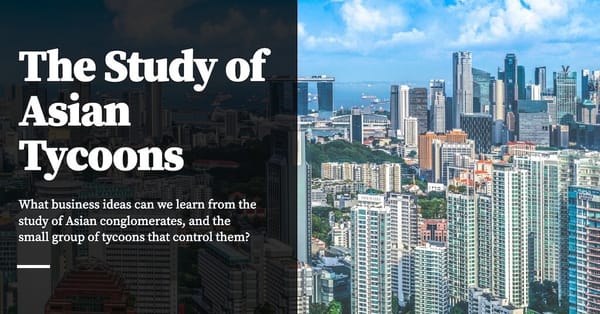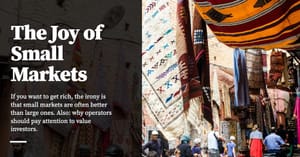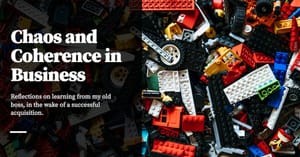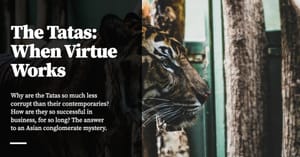Note: This is Part 2 in a series of articles and cases on Asian Conglomerates. Read Part 1 here. You may read more about the Asian Conglomerate Series here, or view all the published cases here.
Everyone who grows up in Asia has lived in the shadow of the great conglomerates. These are many of these companies. The Salim Group, which owns Indomee, the world’s largest instant noodle maker, responsible for so much weight gain in the region’s student populations. Samsung, which dominates South Korea’s economy, and makes semiconductors and good smartphones. Far East Organisation, which owns so much real estate in Singapore. Reliance Industries, which sits atop some of India’s most lucrative industrial markets. The list goes on.
And yet, when I graduated from university in Singapore, I did not think to myself: “One day I will create the next Reliance.” Instead, I thought: “I want to, someday, start a tech company. Maybe I’ll get into Y Combinator. Maybe I’ll create the next Facebook.” Your dreams are determined by what is legible to you; you ape the stories you are fed. In the early 2010s, the stories that I paid attention to — like any good computer science graduate of the era — was the story of the startup.
The story of the startup is extremely legible, and easy to understand. It has had many skilled proselytisers over the years. It goes something like this: you come up with an idea and raise capital from investors. The idea succeeds and your company grows large, and after a decade or so — no more than 15 years, ideally — you go public or sell to an acquiring company, preferably for strategic reasons, at which point you retire rich and are invited to opine about things you can’t possibly know anything about on panel discussions at startup conferences.
The tycoon story is far less legible. It is therefore less popular. It is also … weird? What are you expected to do on this journey? Buy a failed oil plant at age 30, like Jamsetji Tata? Negotiate for a gambling monopoly at age 41, like Stanley Ho? Curry favour with a nascent government to win a foreign currency license, like Lee Byung-chul? Each of the events above were turning points in these tycoons’s respective careers. But in the light of modern sensibilities, they all seem … odd.
A common belief is that Asian business stories are idiosyncratic and random; they require favour and access that no longer exists. So folks hear stories like these and believe there is no replicable path to becoming a tycoon. Whereas the startup story is very replicable (we are led to believe). And so therefore pretty much nobody graduates from university and thinks to themselves: “Ahh, I want to be the next Dhirubhai Ambani.”
If you’ve had a bit of experience with business, though, you will quickly recognise the lie in the previous paragraph. Startups are no more replicable than Asian conglomerates. The only thing that is common to all startup stories is the funding mechanism: that is, someone is open to giving you capital for something new. The availability of such capital is what gives the startup path its legibility.
But legibility is a poor reason to do something. Legible paths tend to be overcrowded. Perhaps there are other ways to building a large business.
Which brings us to our first question.
Why Study Asian Tycoons?
There are two goals for the Asian Conglomerate series. This doesn’t answer the ‘why study tycoons’ question — but we’ll return to that in a second.
- The first goal is to make Asian tycoons more legible. Legibility increases the set of what is possible in your head.
- The second goal is to explain the shape of the game of business in Asia, for two reasons: a) so you can pursue it for yourself, if you choose to. Or, b) so you don’t get blindsided, if you find yourself dealing with Asian businesses of this type sometime in your career.
I am making the second goal explicit because I want to make clear that this is not an academic exercise. I’ve been obsessed with Asian conglomerates for a long time, but the obsession has been that of a businessperson. This series is intended for use.
Much of this will be members-only, and will be published behind the paywall. This is by design: we will talk plainly about politically incorrect things, including smuggling, corruption, power, and in at least one case, alleged assassination. All of these events have been publicly documented; the series will not use any private sources, even on the occasions where we have access to them. We will present these cases as neutrally as possible, so that you may form your own opinions. I guarantee you that there are patterns worth observing in the cases here. My commentary will come in dribs and drabs — just enough to let you spot trends in the beginning, but then more in the later parts of the series.
But let’s return to the first question: why study Asian tycoons?
I have two answers to this question, depending on whether you live in Asia.
If you do not live in Asia, Asian conglomerates are useful to study because they represent an older form of business still present in Europe and the West — if only less prominent. Notable Western conglomerates of this type include Koch Industries, Mars, Incorporated, LVMH, the Wallenberg family businesses (with a holding company hilariously named Investor AB), the Burkard-Schenker family, which owns chemicals conglomerate Sika, the Graham Holdings Company (formerly the Washington Post company), and the Ochs-Sulzberger family, which controls the New York Times Company, which in turn holds a variety of (mostly) media businesses.
In the late 2010s, a typical Western founder will say that they intend to build the next Google, or Facebook. In the 1980s, they might say Xerox, or Kodak. Far fewer from any period will say that their goal is to build a diversified family-controlled holding company with interests in a variety of industries, such that the conglomerate may persist over generations, through recession and war and general geopolitical instability. And yet some do aim to do exactly that, and they accomplish it.
Expanding the set of company prototypes in your head will help you see forms of business you might not otherwise be aware of, or sensitive to. It just so happens that the family-controlled conglomerate is a much older form of business than you might expect. (We’ll get into this later, but it is one of my beliefs that if World War breaks out again, the companies that will emerge in the wake of such destruction will look more like these diversified conglomerates — a function of incapacitated capital markets.) But with all that said, companies that are designed to create and then preserve family wealth are typically boring, and boring businesses don’t get written about as much.
If you do live in Asia, Asian conglomerates are useful to study because they are the product of the business environment around you. It is silly to ignore them, for the simple reason that it is dumb to ignore what has already worked in a market (and not just for historical reasons — these large conglomerates are often also investors, or counter-parties). Most importantly though, it is a waste to not study their playbooks so that you may copy certain moves for yourself.
Perhaps an analogy is in order. Let’s say that you are a botanist, and you visit California and marvel at the massive redwoods that grow there. “I will transplant these trees to Asia”, you say. “I will grow massive redwoods in Malaysia.” You spend years trying to get a seedling to grow in the rainforest, but neglect the study of old growth belian trees in your backyard. Studying startups from Silicon Valley is probably a good idea. But studying the large businesses in your neighbourhood is perhaps just as — if not more — revealing; local conglomerates, like the study of local trees, can tell you much about the soil around you.

I once had lunch with an ex-Uber person, whose job was to hop from country to country throughout South East Asia, launching the service. “Something very odd happened when we met up with these local bosses,” he told me, “Most of them asked to do a joint-venture with us, split say 50-50. We refused, of course. We told them we could give them allocation in our next funding round. But they didn’t like that.” I told him that in the early years of Grab — the local Uber clone — founder Anthony Tan would set up JVs with local taxi bosses across the region. (Sometimes under duress). But Tan understood how the game was played; he was the scion of a small conglomerate named Tan Chong Motors. Uber was, ultimately, overstretched. Years later, as part of a deal with Softbank, it left the region entirely.
It is tempting to believe that business models are context-free, and may be replicated in any country on the planet. (It is tempting to believe that redwoods can be grown everywhere). But reality is more complex. Silicon Valley startups are the product of the political systems and markets in their ecosystems. Asian conglomerates are a product of the political systems and markets in Asian ecosystems. Because why would they not be?
It’s useful to understand how the leaders of such conglomerates see the world, and how they groom their sons and daughters to see the world. You’ll find that the worldviews of these families are different from those in the middle class in these regions, and that most of them understand the game they’re playing better than we do, as of course they should.
Early Themes
We’ve opened the Asian Conglomerate series with two cases, both on Stanley Ho. I wrote that Stanley Ho’s life is illustrative of many of the concepts that we will see again and again as we study Asian tycoons. Here are a few themes that you might want to pay attention to; as promised, I won’t give you too much commentary at the start of this series. I want you to come up with your own opinions and observations.
But with that said, it is helpful to call out certain patterns. Here are three.
What Differentiates Them?
The big question when examining Asian Tycoons is quite obvious, I think: what differentiates the tycoons from the rank-and-file merchants that dot the region? My maternal grandfather’s family owned a coconut farm. Why didn’t he become a tycoon? Similarly, trading is commonplace in Asia; in Malaysia and Singapore, for instance, many overseas Chinese became traders or opened small businesses as a by-product of economic segregation under the British. Why did only some of these merchants become tycoons?
(To explain quickly: during the colonial era the British approach to rule was to divide and conquer: in Malaya they divided the major races into different vocations so as to dissuade them from unity — in fact they wanted some enmity between each race. Tamils were brought in to tap rubber; Ceylonese recruited to become legal administrators throughout the empire; Chinese labourers migrated south (to ‘Nanyang’ or the Southern Seas, as they called it) and became coolies or miners. They were often left to run businesses. This gives us a partial explanation as to why so many of the savviest businesspeople in these two countries are Chinese: they were forced to go into business for themselves.)
So, amongst the Chinese traders, why did some become rich and large, and others remained small? The easy answer is that some merchants gained access to a monopoly, like Stanley Ho, Henry Fok, and Cheng Yu-Tung, the shareholders of gambling company STDM. A government-granted monopoly is, effectively, a moat: it means that your margins are protected from competitive arbitrage. (In the terminology of 7 Powers, the moat present here is a ‘cornered resource’.) The cash flow thrown off from a moat-protected business may be used to diversify one’s holdings into a dozen different things:
Early on, Ho pioneered hydrofoil travel in Asia between Macau and Hong Kong, replacing the previous overnight cruise with a one hour jaunt. (STDM pays gaming tax of 38% rather than the 39% levied on the other concessionaires in exchange for harbor maintenance, including dredging). Ho’s Shun Tak Holdings assembled one of the world’s largest hydrofoil fleets, developed its Hong Kong terminal into a major shopping and office complex and was listed on the Hong Kong Stock Exchange in 1973.
Under Ho’s direction, STDM invested in infrastructure, including Macau International Airport, flag carrier Air Macau and the city’s first iconic convention venue, Macau Tower, and ran horse and dog racing. It also took stakes in banks, hotels and properties, including Macau’s only department store, New Yaohan, which it rescued when the chain went bankrupt in 1997. By then, it was hard to spend a dollar or pataca in Macau without Ho getting a piece of it.
We saw this also with Ho Yin, in Macau, who gained monopoly control over the gold trade after Pedro Lobo died:
(As a measure of his wealth, a Straits Time article reported that in 1966, Ho Yin’s assets included “controlling interests in Macao’s only bus and taxi companies, all 10 cinemas, two Chinese language newspapers, five hotels, four banks, and a modern greyhound track.”) The gold trade was, apparently, very profitable, and continued under Ho Yin in the form of Ng Fuk Tong, or the Five Good Fortunes Association.
But we can go deeper. Merchants who sought a moat would grow their businesses and become large; merchants who did not seek a moat would struggle forever in vicious competition and fail to grow. Why did some merchants seek out a moat, and others did not? The trite answer is ‘luck’. The more interesting answer is that some merchants were more perceptive than others.
It is indeed true that luck plays a role: initially, Ho was not interested in the gambling monopoly in Macau. He fell into it — he was brought in by his brother-in-law. But once he won, Ho, more than any of his partners, saw the potential in gambling. He knew that with the monopoly in his control he had it made; it was lucrative enough to power the rest of his career. He was right.
Ho had an ability to recognise opportunity when he saw it. Not every merchant was like him. Why?
We’ll return to this question later in this series. For now, I’d like to leave this as a mystery for the alert reader.
Opportunistic Diversification
The second pattern I want to call attention to is the endless diversification present in all of these stories.
We saw this with the Fus, who were ambivalent about gambling:
After World War II, Fu Tak Iam began to diversify aggressively outside of gambling. He decided that the next generation would not follow him in the casino business; by this point it was clear his son — Fu Yum Chiu — had no interest. He sent Yum Chiu to Hong Kong in 1946, a year after the war ended; the son set up Kwong Hing Investment (KIH) Holdings the following year. KIH would then begin expanding into interests in property, shipping, construction, cinemas and trading in Hong Kong.
Fu Yum Chiu also set up Tak Kee Shipping & Trading Company in 1947. This became a property development company, eventually reorienting to take advantage of the same Hong Kong building boom that so many businesspeople were engaged with after the war. Eventually, Tak Kee would build and launch The Furama Hotel in 1973, a 500 room, 5-star hotel that set the standard for business hotels in the region. (Furama continues to be an active hotel brand today, though based out of Singapore. The family divested its holdings in 1997).
All of this is to say that the Fus actively funded the expansion of their family empire through the cash harvested from their gambling monopoly in Macau, a position they held for 24 years. Fu Tak Iam died in 1960 after a period of declining health; he was 65 years old.
And we saw this with Ho Yin, with Henry Fok, with Cheng Yu-Teng, with Stanley Ho, and with Pedro Lobo. Some of these tycoons were more diversified than others. But every single one of these tycoons are more broadly diversified than you might expect.
A modern Western company would not be so willing to expand into so many unrelated industries. An Asian conglomerate would. Why? What explains the difference?
Note that this difference didn’t use to be so stark: in the 60s, it was more common to find broadly diversified American conglomerates — the result of a speculative mania. Today, there remain several European conglomerates that are broadly diversified. But by-and-large, Asian conglomerates are more diversified than their Western counterparts (if there are at all conglomerates worth comparing to).
It’s worth asking why there is this difference. Again: exercise for the alert reader; we’ll talk more about this later in the series.
Shrewdness, Opportunism, Hunger and Luck
The final thing I’d like to point out is something that I won’t return to in the future. I’ve found that it’s useful to ask: “what traits do these businessmen display?” followed by “what would I do if I were put in their shoes?” — mostly as a way to relate to them. I recommend this exercise; I find that it makes the stories come alive for me.
There is a trap here, which is that you believe the nonsense that biographers are prone to include in their profiles of Asian businessmen. To quote Indian journalist Sacheta Dalal, writing in July 26, 2000:
Why aren't there more accurate biographies about Indian leaders? Or rather, why are Indian biographies usually worshipful eulogies of their subjects? The answer probably lies in the fate of Hamish McDonald's book on Dhirubhai Ambani titled The Polyester Prince.
Usually biographies in India are commissioned works — sanitised and censored. As McDonald says — ‘No one (the subject of the biographies) drank, cursed, cheated or philandered. Their workers were part of the family. Almost everyone lived an abstemious vegetarian life, accumulating wealth only to give it away to temples, hospitals and schools.’
This is true not only of Indian businessmen, but also that of Korean and Chinese and Indonesian tycoons. The vast majority of tycoon biographies are thinly disguised hagiographies. It takes work to unearth what is interesting about their businesses and their lives. Over the course of this series, we will take great care to include a little of what these tycoons say, and also include — where appropriate — what is said about them. But overall it is more important to look at what they do.
Take the Stanley Ho cases, for instance. Looking at the history of actions that Ho took over the course of his very long life, and comparing those actions with the other tycoons present in his case, I would say that Ho was:
- Shrewd — we’ve talked about the shape of that shrewdness in the mini series on Power in Business. At this point, you should also have an idea about how he became shrewd. I happen to think that Ho was more shrewd than most of the other tycoons in his world.
- Opportunistic — the vast majority of Ho’s activities were the result of simple opportunism. He saw a gap — in ferry services, in real estate development in Hong Kong, and then in many other businesses in Macau — and he filled it. Of course, he wasn’t the only one: it seemed like every tycoon was involved in Hong Kong property in the 50s and 60s. As far as tycoon traits go, this isn’t particularly unique. A Chinese businessman once put it, crudely, to me: “if can make money why not do?”
- Hungry — it’s worth asking what drove Ho. Why did he do so many things in his life, why did he start so many businesses? Perhaps he was motivated by money. Perhaps he had a chip on his shoulder to be successful. (What type of man, I ask myself, has four wives, and seventeen children, and competed in ballroom dancing competitions until late into his life?) It’s always hard to say with these things, but worth dwelling on a little; as much as I talk about the mechanisms of moats and the nature of operational excellence, a lot of business boils down to the character of the people involved. I linger on the fact that Ho did more with the gambling monopoly than Fu Tak Iam ever did.
- Lucky — Ho owes much of his success to luck. But in this, he is like any other outlier success — where there is wild success, there is always an element of luck involved. What I hoped these cases demonstrate, though, is that nothing was guaranteed in his life. It is too easy to say that “Ho was born into a prominent family, developed a lifelong mentor in Pedro Lobo in his 20s, and then was destined for greatness once he won the gambling monopoly.” In truth, he could’ve died or failed at any point along the way.
I’m not claiming these traits are predictive of anything. We’re going to examine many more tycoons over the course of these series, and not all of them are as shrewd or as opportunistic or as hungry or as lucky as Ho. I’m including this set of observations here only because I want to encourage you to ask these questions of the tycoons we will examine over the course of this series. The more alive they seem to you, the more you might find yourself thinking “ahh, I think I can do what he did, given the same circumstances.” Or, alternatively: “holy shit, that guy is insane, there is no way I could do that.”
If we remove opportunism and hunger from the list above (they are not that rare amongst the tycoon set), what remains is shrewdness and luck.
Shrewdness and luck: I like that. That seems like the kind of thing Chinese mothers would pray for. There are worse traits to wish on your children.
Wrapping Up
We’ve only looked at one tycoon so far. There isn’t much to conclude from a single case.
But there are plenty of questions to ask about the next few cases. The most basic questions are comparison questions:
- What are some surprising similarities between this case and the previous cases we’ve examined?
- What are some surprising dissimilarities between this case and the previous cases we’ve examined?
And then, a few other questions:
- At which point did this tycoon gain their moat-protected business? How did they do it? How did that business enable them to fund the expansion of the rest of their empire?
- How opportunistic were they — both in diversification, and in exploiting openings in the market?
- What makes them different from the other tycoons? What makes them different from the regular merchant?
- Can you put yourself in their shoes, and do what they did?
In the next instalment, we’re going to look at Samsung.
This is Part 2 of The Asian Conglomerate Series. You may read Part 3 here: The Story of Samsung.
Originally published , last updated .
This article is part of the Market topic cluster, which belongs to the Business Expertise Triad. Read more from this topic here→
This article is part of the Capital topic cluster, which belongs to the Business Expertise Triad. Read more from this topic here→





